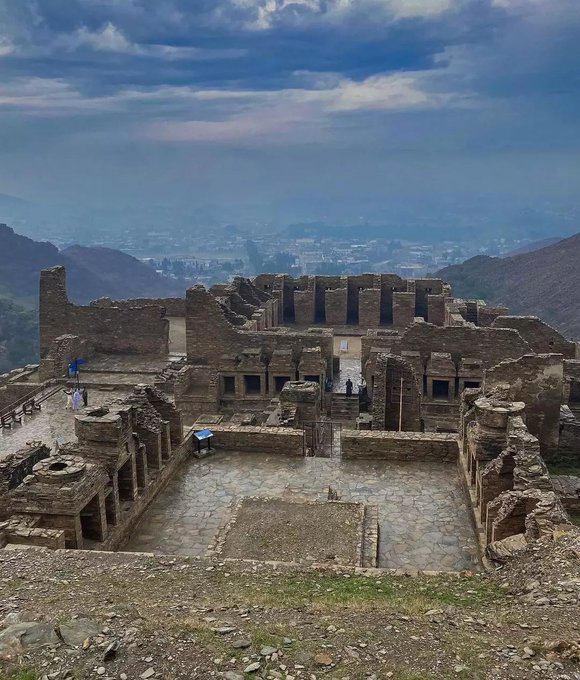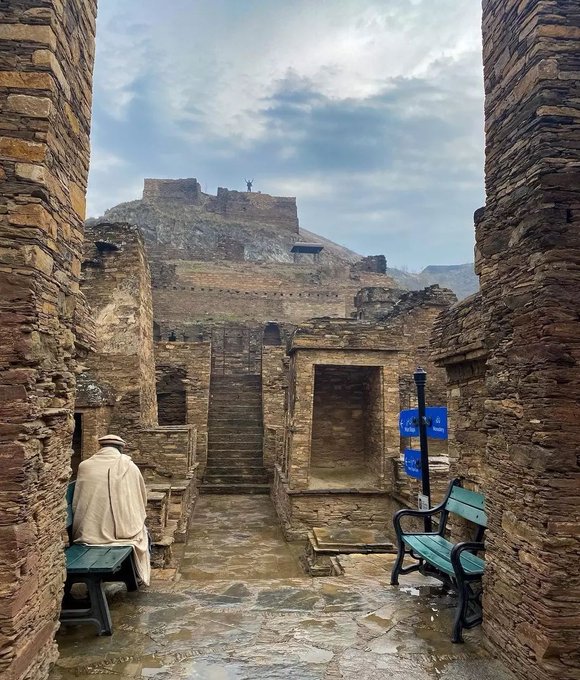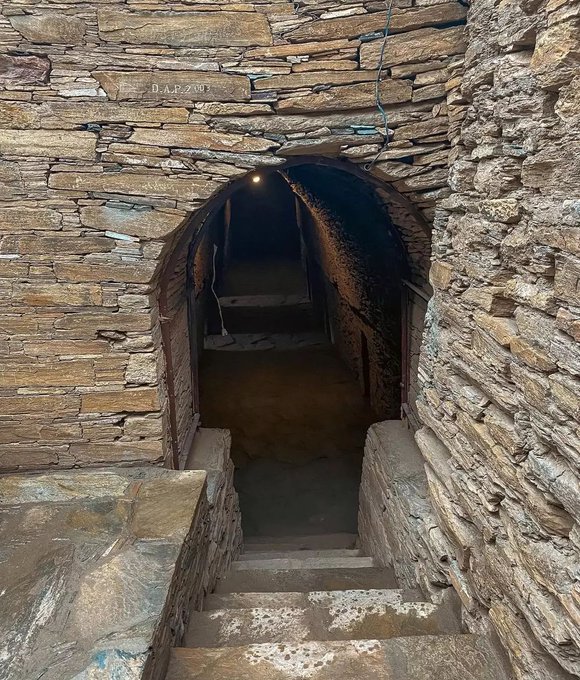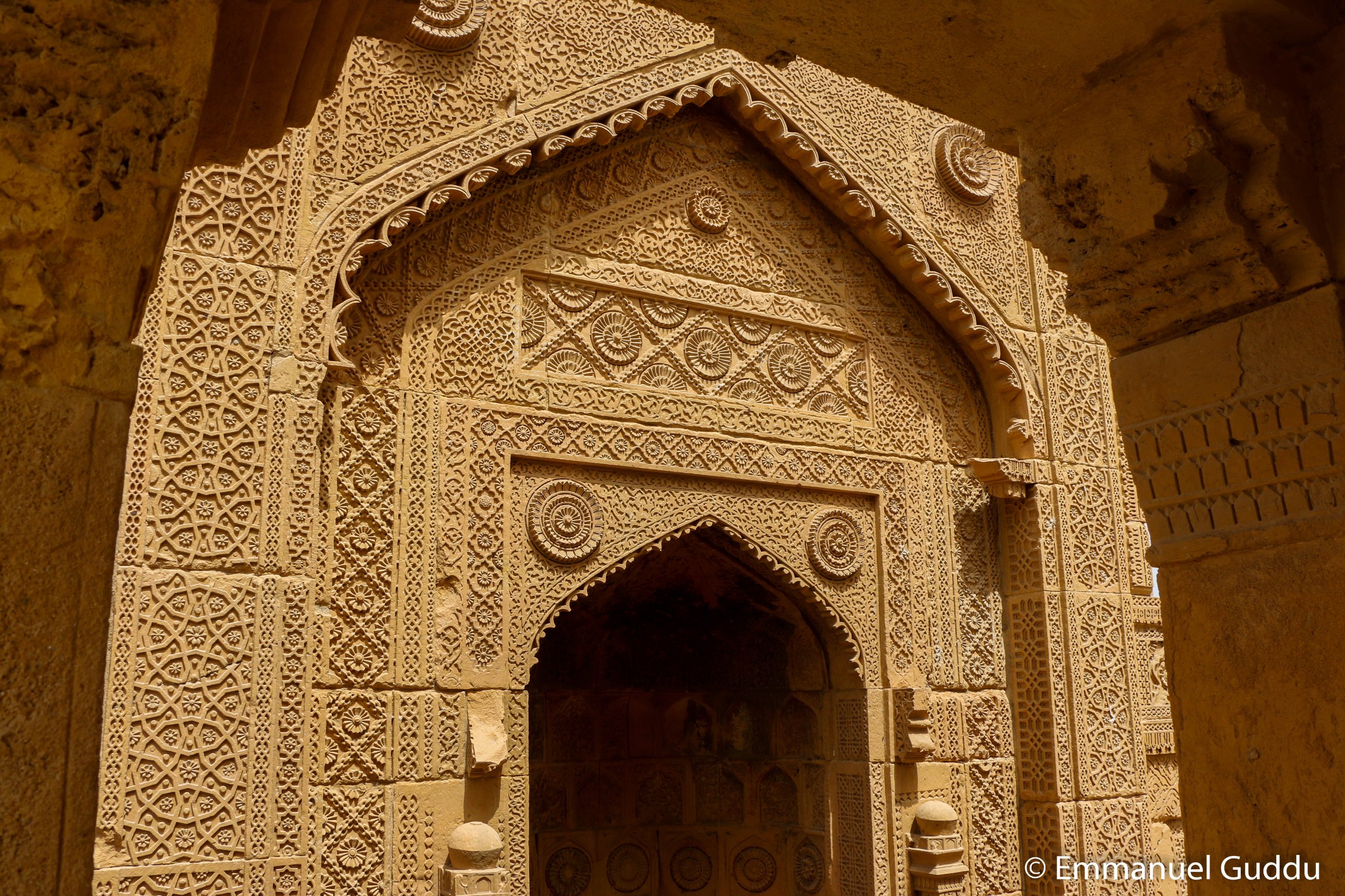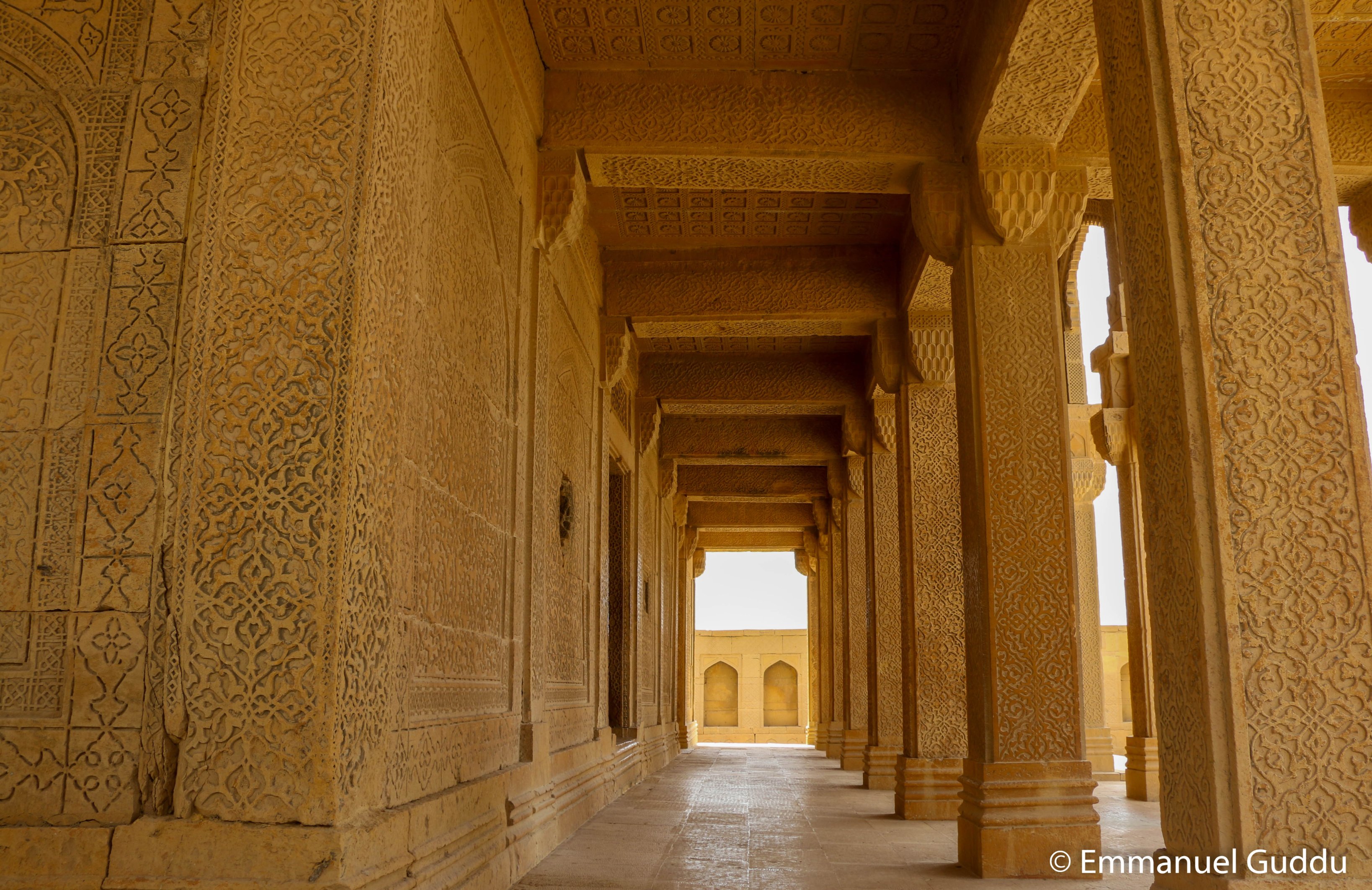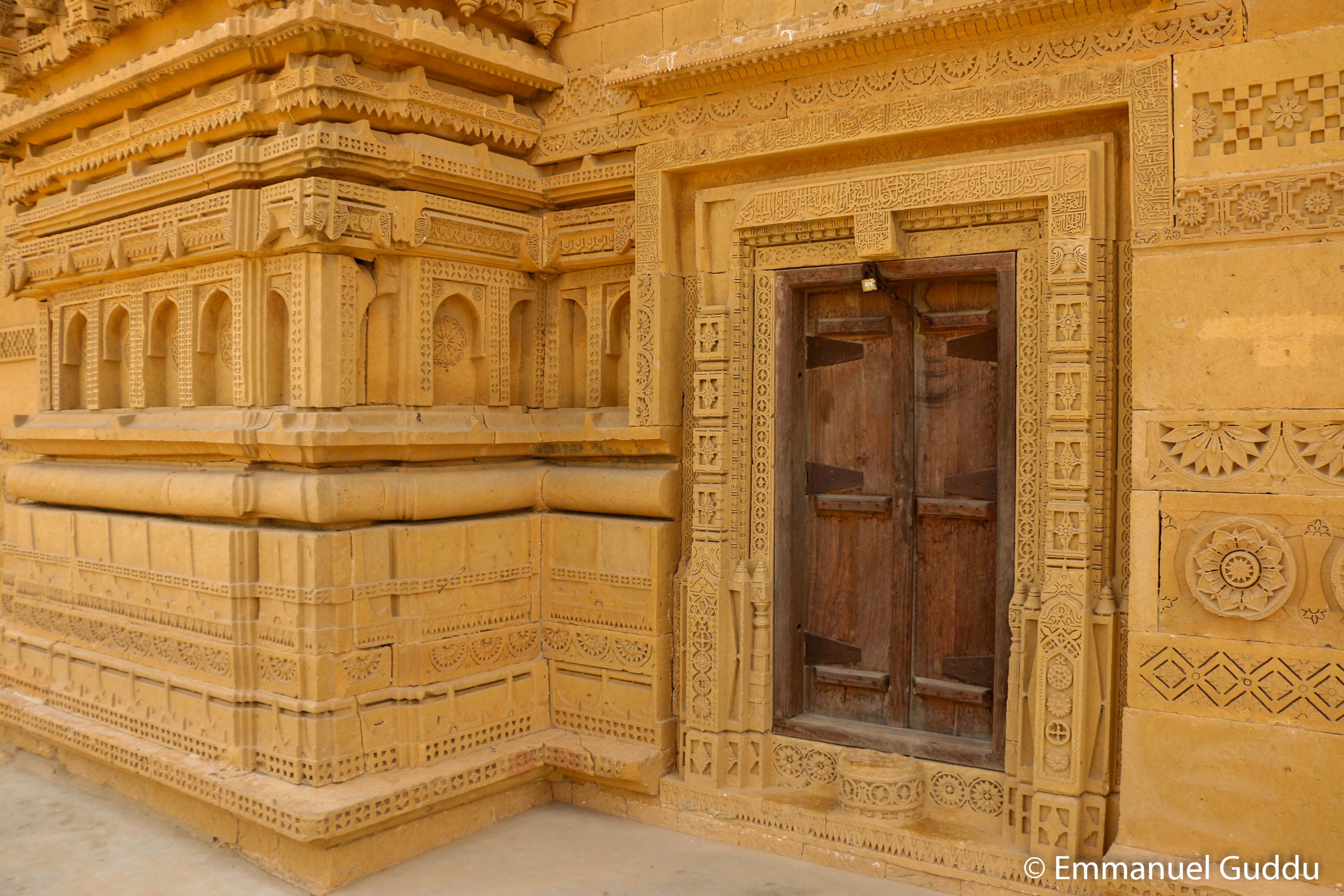Ali Bhutto
September 8, 2024
The archaeological site of Nahuto, in Umerkot district, where artefacts dating back to the Hakra Ware Phase and the Mature Harappan Phase have been found | Photos by the writer
The bangles cover Radha Kohli’s arms from wrist till shoulder and resemble a coat of armour. Radha, who says her name means “God’s wife,” is the only midwife for miles in the area surrounding the village of Nahuto. This western periphery of the Thar Desert is referred to in the local dialect as ‘Mohrano’, or the beginning, where the dunes gradually give way to the fertile plain of the River Indus.
Radha is known as the village doctor and turns up when called, even if at midnight, in the villages that lie in the vicinity. Trained by her mother-in-law, it took her thirty years to master the art of delivering babies. “Of the nine women in the house, she chose me,” she tells Eos.
In the Thar Desert, bangles signify marital status. Jheeni Kohli, who says her name means “soft-spoken”, discarded her bangles the day her husband died. Like most women in the village, her palms bear the rope-marks of years spent drawing water from wells.
THE LOST CITY OF NAHUTO
Local lore has it that the perennial Hakra River once flowed half a mile from Nahuto. The story goes that the area was a trading post of nine-hundred huts — or shops — and it is from here that the village gets its name — pronounced Nau-hut-o — according to Faqir Irshad Kunbhar, a local resident. One of the defining characteristics of the lost city was the large number of washermen that could be seen washing clothes along the banks of the Hakra.
Within sight of the village, amidst shrubs of euphorbia, lies a mound littered with shards of pottery, bricks and occasionally, bones. It is locally referred to as Nahutojo Bhiro. The word bhiro is the Thari equivalent for daro, or mound, and the name translates into the Mound of Nahuto.
Hoth Khashkeli, a resident of the neighbouring village of Mohobat Ali Shah, was among the locals hired by the provincial department of archaeology to help excavate the site in 2018. Hoth points to the exact spots on the north-eastern side of the mounds, where trenches were dug and then refilled with earth to preserve the ruins.
Despite being among the most advanced of the ancient civilisations, little is known about the Indus Valley Civilisation to this day. Ali Bhutto examines its various aspects, including evidence that hints at a strong matriarchal element, and a lesser-known archaeological site on the peripheries of the Thar Desert…
The excavations lasted three months and were conducted by Qasid Mallah, the chairman of the archaeology department at the Shah Abdul Latif University in Khairpur, and a six-member team. “They said the site was around five-thousand years old,” Hoth tells Eos.
Hoth’s eyes light up when he talks about the skeleton of a large fish that was unearthed here, in the middle of the desert. He also recalls seeing an ornament that depicted the head of a crocodile. (In the winter of 1926-27, a 2.5-inch crocodile head made of shell had been found by the archaeologist Daya Ram Sahni in Mohenjo Daro).
Muhammad Hassan Khashkeli, another local who was among the excavators at Nahuto, says that beads and figurines had also been found. The Sindhi word he uses to describe the latter is “goodi.”
Mallah tells Eos that the site dates back to the Hakra Ware phase (3500 to 3000 BC). The most common find was Hakra pottery, which is handmade, but there was also material dating to the period between 2600 and 1900 BC, when cities like Mohenjo Daro and Harappa were flourishing.
Based on the evidence collected, he believes that this too was once a large city. The artefacts found included human figurines, jewellery and the skeleton of a fish that, when living, would have weighed around 10 kilogrammes, according to him.
“Nahuto was the gateway to Gujarat [in modern-day India],” says Mallah. It served as an ancient junction of sorts. Caravans travelling from the area that is currently Gujarat would have passed through here to get to the cities of Mohenjo Daro, Chahunjo Daro and Lakhanjo Daro, according to him. Similarly, the spot would have been central to journeys made in the opposite direction.
Asma Ibrahim, an archaeologist who is also the founding director of the State Bank of Pakistan Museum and Art Gallery, believes that there was constant intermingling between the people of the Indus Civilisation and those of the wider region, including Central Asia.
Ibrahim, who has done a post-doctorate in archaeological chemistry and whose area of focus is ancient human bones, tells Eos that there was a continuous influx of people across the Kirthar Range, throughout the third millennium BC and earlier. She describes it as a slow migration.
“We have evidence that, during the winters, they were coming down to this area and then they were mixing up, and intermarriages were happening,” she says. “It was a very common thing.”
Figurines from Mehrgarh depicted with elaborate hairdos, on display at the National Museum in Karachi
‘THE BLACK LAND’ OF ANCIENT TEXTS
A Sumerian mythological text from the third millennium BC, titled Enki and the World Order, refers to an exotic land called Meluhha. It is described as a place of abundance and an exporter of luxury goods. The text sings the praises of Meluhha, and mentions, among other things, that it is home to the peacock — a bird indigenous to South and Southeast Asia.
In this text, and a later one, titled The Curse of Agade, dating back to the beginning of the second millennium BC, Meluhha is referred to as “the black land.” The reason behind this is unclear, but some scholars attribute it to the black soil of its cotton fields.
A report of the Archaeological Survey of India (ASI), for the year 1926-27, provides an interesting clue. “The Babylonian and Greek names for cotton (sindhu and sindon, respectively) have always pointed to the Indus Valley as the home of cotton growing,” writes John Marshall, the director-general of the ASI. He had found pieces of finely woven cotton and evidence of cotton weaving at Mohenjo Daro.
According to Mallah, “the black land” might refer to parts of Gujarat — where black soil, formed from volcanic rocks, occurs naturally. Similarly, black soil can also be found in the Deccan Plateau.
Nilofar Shaikh, an archaeologist and chairperson of the Centre for Documentation and Conservation of the Heritage of Sindh — located at the Endowment Fund Trust’s office in Jamshoro — tells Eos that all the items mentioned in the Sumerian texts as coming from Meluhha, have been found at Indus sites such as Mohenjo Daro.
On the basis of archaeological evidence, Meluhha is believed to be the Indus Civilisation, according to Shaikh. It covered an area that includes Sindh, Punjab, southern and eastern Balochistan, Gujarat, Haryana, and pockets of Khyber Pakhtunkhwa, Indian Punjab, northern Rajasthan, western Uttar Pradesh and southern Jammu and Kashmir.
Marco Madella, an environmental archaeologist and professor at the Pompeu Fabra University in Barcelona, who has surveyed Sindh for potential archaeological sites, describes it as a very international civilisation. “It had connection with many parts of the world. And to think that was 5,000 years ago, that’s something incredible,” he observes.
One of the statues found by KN Dikshit in Mohenjo Daro, on display at the National Museum in Karachi. Archaeologists believe the statues were a reflection of how women of the Indus cities dressed
ECHOES OF THE PRESENT
Kaleemullah Lashari, who heads the Technical Consultative Committee for National Funds for Mohenjo Daro, believes that using the translation of certain words might result in people missing the context, while referring to terms such as Meluhha and the black land.
“It is often said that Meluhha may have been an area that included Makran, Sindh and parts of Gujarat, or it may have been an area within this larger region,” Lashari tells Eos. There were reasons why specific words were used and they often had connotations that were very different to what they are translated into, according to him.
“Of all the artefacts found at Indus sites, we have mainly jewellery more than anything else,” observes Tasleem Abro, who is the director of the Archaeology and Anthropology Museum at the Shah Abdul Latif University, Khairpur. “We have found women’s finger impressions on pottery,” she says, adding that even back then, they were “working women.”
The custom of wearing bangles on the entire length of the arm was widespread among women in Sindh up until about 200 years ago, after which it reduced significantly, according to historian and scholar Badar Abro. “Thar is the living museum of Mohenjo Daro,” he says.
“One thing we have to be careful [about] is not to try to connect things in a direct way, because, at the end of the day, if you want to use some adornment on your arms, what do you have? Bracelets,” says Madella. “The same object, when we move it from one society to another, can have radically different meanings,” he adds.
While conducting excavations at Mohenjo Daro in the winter of 1924-25, the archaeologist Kashinath Dikshit found a seven-inch statue of a female adorned with jewellery and an elaborate headdress. He would, over the course of that season, unearth 200 human figurines, mostly female.
Dikshit associated these with the cult of the Mother Goddess and noted in his report that “the female energy, or ‘mother principle’” were central to some of the earliest forms of worship in the ancient world. He believed, as do some archaeologists today, that the sculptures are a reflection of how the women of the Indus Civilisation dressed.
Over the next two years, Dikshit recovered two hoards of ancient jewellery in gold, semi-precious stones and ivory. The items included bangles, ear ornaments, hair clasps, combs, hairpins and a necklace.
In the excavation season of 1925-26, another archaeologist, Madho Vats, found a copper statuette of what “appears to be a dancing girl,” according to his colleague Sahni’s report for that year. This label seems to have stuck, as it was used in the reports that followed and is applied till this day.
In the following year, Sahni would find another “naked dancing girl.” He noted that one of its arms was “covered with bangles from the shoulder to the wrist.” Similarly, in 1930-31, a third statue, also referred to as a dancing girl, was found by British archaeologist Ernest Mackay.
It emerges from these early reports that the ‘Priest King’ label, like that of the dancing girl, was a result of an attempt to describe and make sense of an artefact. When the male bust was found by Dikshit in 1924-25, Mackay wrote in the report for that year, “It seems probable that this head is that of a priest, for priestly statues have been found in Babylonia, wearing garments very similarly decorated with trefoils”.
Ancient jewellery in gold and semi-precious stones on display at the Harappa Museum
THE MATRIARCHS OF THE INDUS
Among the numerous seals that surfaced in Mohenjo Daro, there were some that depicted a human figure wearing a horned headdress, seated in what Mackay describes in his report for the year 1928-29, as “a yoga attitude.” The figure’s arms, Mackay writes, are “adorned with bracelets.”
Indian archaeologists Madhukar Dhavalikar and Shubhangana Atre believe that the figure in the seal is a female. In a research paper published in 1989, they refer to it as “Lady of the Beasts,” or the goddess of fertility.
According to Dhavalikar and Atre, two other seals, found in Mohenjo Daro showing a religious ritual, contain depictions of female devotees and a high priestess. In the seals, the devotees are shown with long braids, while the high priestess wears a horned headdress.
“Women had a very high place in that society,” says Asma Ibrahim, adding, “We have come to know that women were the head of the house.”
A stroll through Mohenjo Daro’s residential neighbourhood reveals that its inhabitants enjoyed better standards of living than most people of the area do today.
In the late eighties, a group of physical anthropologists conducted studies on skeletons in a cemetery at Harappa and found that the women buried there were closely related to one another, while the men weren’t related to each other, or to the women (Pakistan Archaeology, 1993).
Indus figurines on display at the Harappa Museum
On the basis of these findings, American archaeologist Mark Kenoyer, who was in charge of the excavations, writes in Ancient Cities of the Indus Valley Civilisation, that “a woman was buried near her mother and grandmother, and a man was buried near his wife’s ancestors rather than his own.”
It seemed to suggest that it was the husband who was entering the wife’s family, rather than the other way round. Kenoyer goes on to mention that further studies are needed to confirm this theory.
“Genetic studies from the Indus are problematic, because there are not many cemeteries in general,” says Madella. The other problem, he tells Eos, is that the climate of the region is not conducive to the preservation of organic material, such as DNA or collagen, in skeletons. There is, therefore, “very little preservation of the molecules that would have been used for doing this kind of analysis,” he notes.
Lashari tells Eos that the matriarchal element grows stronger the further back one goes, to settlements in the Greater Indus Region, such as Mehrgarh, a site in Balochistan, believed to date back to the 8th millennium BC.
“The radiocarbon chronology of Mehrgarh is a complete disaster and it is absolutely unreliable,” Italian Paolo Biagi, an archaeologist and senior researcher at the Ca’ Foscari University of Venice, tells Eos via email.
“They made just a few dates, which are very obsolete and the results do not follow the suggested techno-typological sequence,” Biagi says. The only way to know the real chronology of Mehrgarh is to date as many of the human bone remains as possible, he adds.
Mehrgarh figurines dating back to the end of the fourth millennium BC are described in the Mehrgarh Field Reports 1974-1985 as having “heavy pendulous breasts” and a “hooked nose.” Figurines from this period, and the ones from the middle of the third millennium BC, have elaborate, even glamorous hairstyles, setting them apart from those found at Indus sites like Mohenjo Daro and Harappa.
According to Asma Ibrahim, a study needs to be conducted on who was making these complex hairdos during that period and the specialised skills involved. “They have more than five-hundred hairstyles in Mehrgarh,” she says, referring to the figurines.
“If you look at the comparison between the Early Indus period [3300-2600 BC] and the Mature period [2600-1900 BC], there’s a lot of change,” says Nilofar Shaikh. “There is continuity — we have evidence here, but suddenly we have these cities rising up on the banks of the rivers,” she adds.
During this period, there is another change: items in ivory, gold and silver, are being produced on a large scale in Indus cities, whereas in the earlier period, there are only one or two odd cases of gold or silver being found, according to Shaikh.
She says that studies need to be carried out on what triggered these changes. The transfer of technology“ and ‘the exchange of knowledge’ were a result of constant contact with the wider region, including Mesopotamia and Sistan (Iran), according to her.
“Until and unless our own script is deciphered — of the Indus — we cannot say much,” she says.
The writer is a Karachi-based journalist who has written for local and international publications.
His work can be found at alibhutto.com
Published in Dawn, EOS, September 8th, 2024








